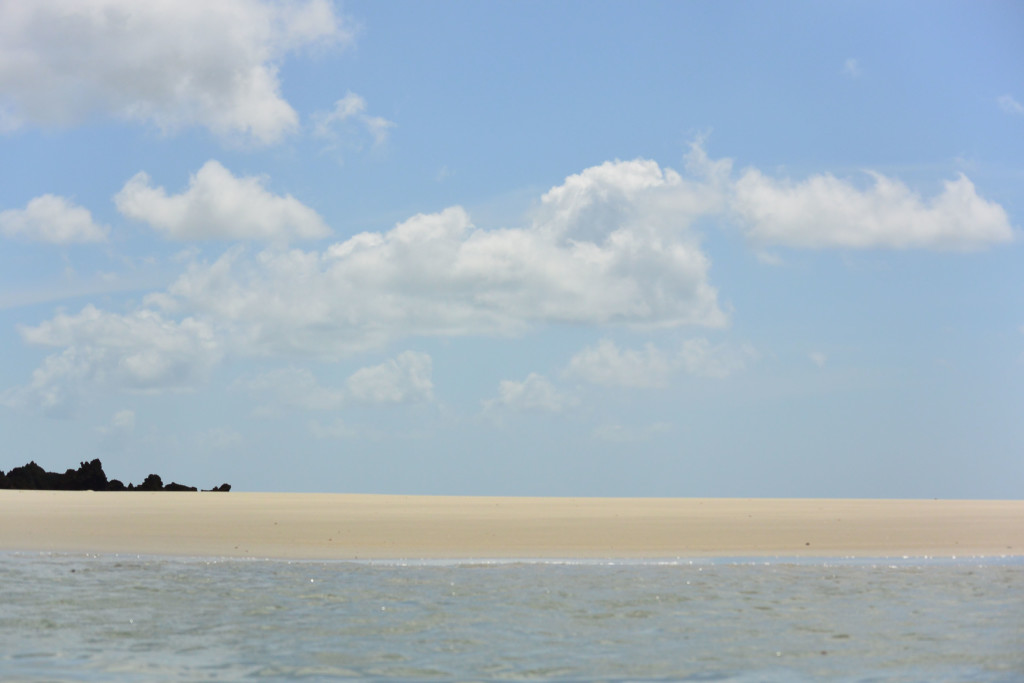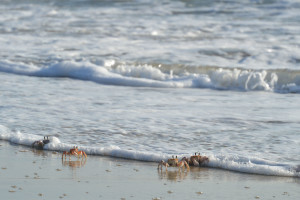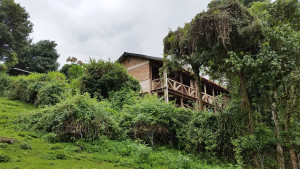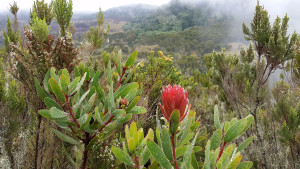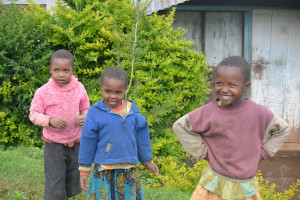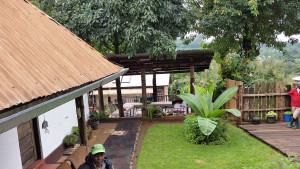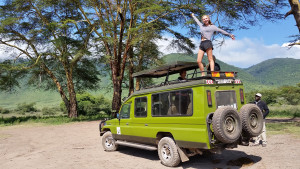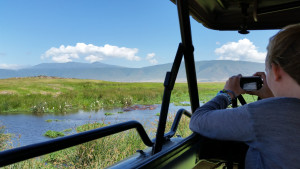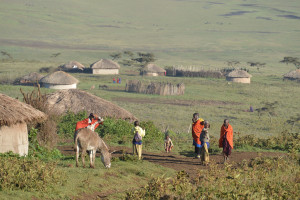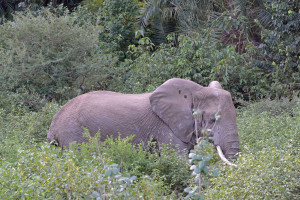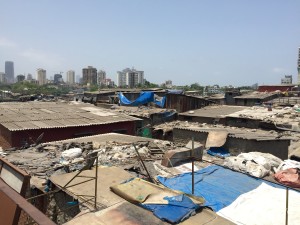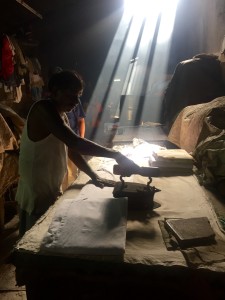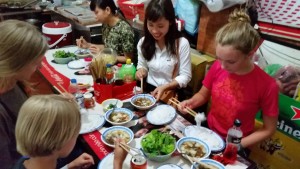
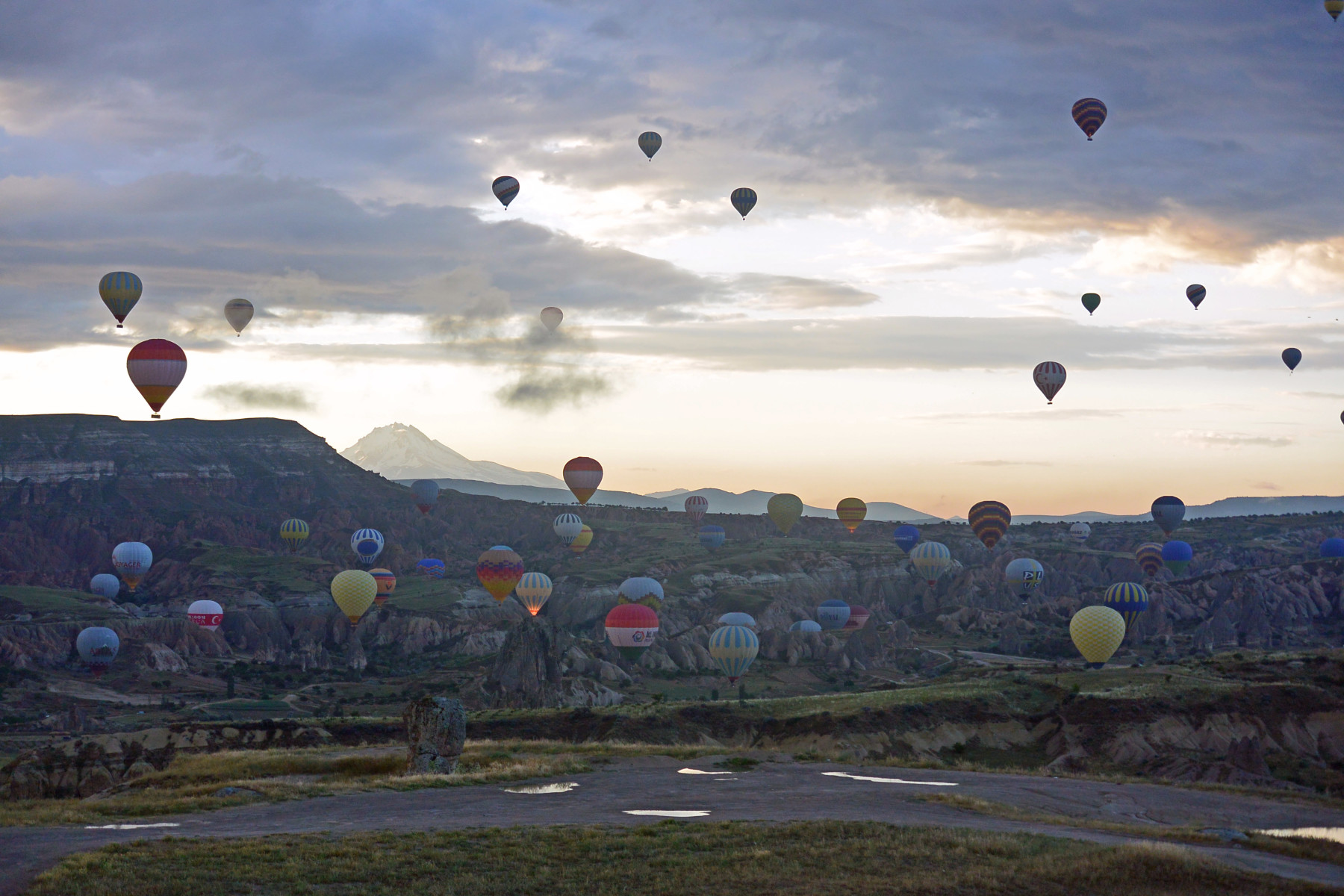
We arrived in Turkey after a seven hour flight from Africa. Our hotel was next to many famous churches and mosques including Haia Sophia and the Blue Mosque.
While exploring in Istanbul one day we got poured on. It was raining so hard, the streets were flooded with huge streams of water and we bought some umbrellas from a street vendor J finally it stopped raining and we went to dinner. On the way back, we stopped at ice cream shop where they used a very long stick to scoop the ice cream. With the stick, they would do lots of tricks and would tease the customers waiting for their cones. It was very entertaining.
One day we met up with Ishan, the World’s Best Taxi Driver (add link) for a tour around the city. Ishan is kind of famous as he has his own TED Talk and was Anthony Bourdain’s driver while he was in Istanbul and is featured in Bourdain’s episode on Istanbul called “No Reservations.” Our neighbor Shannon spent 10 days with Ishan many years before he was famous and gave us his contact information. Ishan is hilarious. He also calls himself a great housewife J and invited us to his house and cooked us a delicious lunch. On our day with Ishan we got to see parts of the city that most tourists don’t see.
One of the amazing things about Istanbul that blew my mind for sure is that the city is located in two continents, Europe and Asia!
We ate many delicious types of food in Turkey, but our favorite were the lamb doners and kebabs. The meat for the doners is cooked on a long stick with layers of meat and fat slowly heated. Both of these dishes are very traditional and we sometimes ate them twice a day! Yum.
After leaving Istanbul we spent one day in Ankara where we went to a very cool museum, The Museum of Anatolian Civilizations. Some of the Bronze Age human models were so life like it was creepy – one of the men who was smelting metal in the display actually had sweat on his forehead!
After Ankara, we went to Goreme in the Cappadocia region. Goreme was truly amazing. For thousands of years, people built homes and churches out of the soft rocks in the area and build large underground cities.  The rock formations themselves were astounding. Years of erosion has created tall spikes called ‘fairy chimneys’. Hiking through the rocks valleys and exploring the empty cave dwellings was awesome!
The rock formations themselves were astounding. Years of erosion has created tall spikes called ‘fairy chimneys’. Hiking through the rocks valleys and exploring the empty cave dwellings was awesome!
We were lucky enough to do a hot air balloon ride one morning to see the sunrise. It was super awesome. It was something I will never forget.
Our flight leaving Cappadocia to Izmir was three hours delayed and we didn’t get in the air until nearly 1am. There were many crying babies the whole two hour flight, by far the worst flight of the entire trip. We stayed at a nice hotel in Izmir though and we slept in late and had a delicious breakfast.
From Izmir we went to the ruins at Ephesus. I was really excited to go but it was a little disappointing. It was such an amazing city at its peak, but there is almost nothing left. The Temple of Artemis, one of the 7 Wonders of the Ancient World was there, but today only one column stands. It was sad.
Overall, we were all very glad we went to Turkey. It was one of my favorite countries to visit and I would recommend to travel there if you are looking for a family friendly vacation, definitely consider Turkey!

We arrived in Dar es Salaam not quite certain what to expect during our two weeks in Tanzania. Not terribly excited about spending two days in the city, we booked a couple of nights at a resort in Amani Beach, 35 miles and a short ferry outside of the city. As with many of the places we have traveled these past months, 35 miles can be quite a travel burden with no direct roads and lots of traffic. It took us nearly three hours and a few locals pushing our car out of a muddy ditch to complete our journey. Although it took more effort than we anticipated, arriving at Amani Beach was incredible – a beautiful resort in a remote location on a world class beach. The best part was, with the exception of the crabs, we had it nearly all to ourselves.
Our beach days there were second in enjoyment only to our time in G-Land and a full day was spent exploring the grounds, shelling and swimming in the ocean. Tanzania was off to a very good start and the excitement was building for our Kilimanjaro trek and safari…
We arrived at Kilimanjaro airport on a cool morning from Dar Es Salaam. Our guide, Joseph, from Summit Expeditions and Nomadic Explorers (SENE) loaded us up in a safari customized Land Cruiser and welcomed us to the beginning of the seven day adventure of our lives. The drive west past a few small African towns and onto the dirt roads of Mhabe Farm was filled with views of lush tropical farmland. It was a good omen of things to come when Campbell spotted her favorite bird of all time, a Lilac Breasted Roller, within the first hour after arriving.
The beautiful Mhabe Farm sits at 6,000 feet in the foothills of Mount Kilimanjaro, nestled within the lush tropical forest that envelops the mountain. The farm is a perfect location to access the popular mountain trail head of the Marangu.
Soon after arriving we were warmly welcomed by Simon Mtuy, the founder of SENE and the steward for his family’s farm. He came with an entourage of family and warm friends. Immediately upon meeting Simon we were star struck by his worldly persona. Simon has attained legendary status in Tanzania by all his accomplishments as a world class endurance runner and climber. Besides many top finishes in ultra-marathons around the world, Simon holds the world record in the fastest, unsupported, ascent and decent of Kilimanjaro. Over the next couple days we had an amazing time at Mhabe Farm getting to know Simon and his crew chatting for hours over tea, coffee, beer and many bottles of wine accompanied by an unending succession of incredible meals prepared from scratch with ingredients sourced from the farm’s gardens. We encourage you to read more about Simon here (http://www.nomadicexperience.com/wp-content/uploads/2012/03/Simon-bio-long.pdf)
Simon’s right hand man, Wilson, was also an amazing person. At over 70 years old, he has reached the summit of Mt. Kilimanjaro over a 1000 times. His warm, gentle disposition and knowledge of the area was invaluable.
The weather at the Mhabe Farm was not ideal (rain and low lying fog most days) but the great company, rich culture and local fauna made up for it in spades. On the morning of our trek, we set off early for a 20 km hike up to the Mandara Hut and the Maundi Crater, which is the first camp on the way up Kilimanjaro. Our guides were Simon’s brother Felix and neighbor Mumbasa. Mumbasa not only carried our lunches on the trail, he packed in a full size set of wooden salt and pepper mills that must have weighed a good kilogram – but made our hard boiled eggs taste so much better!
We were the first group to reach the hut where we had lunch in the presence of two giant ravens. After lunch we continued onto the Maundi crater. The flora had changed from rain forest to mountain foliage. At the crater the weather was still foggy with limited visibility, but we enjoyed many local scenes like the water soaked Protea flower which is the national flower of Tanaznia. We circled the crater and then descended back to the hut and the Mhabe Fram. To everyone’s great surprise the whole trip turned out to be 35.1 km (miles) which was a big Lund family hiking mile stone.
Our last morning at the farm were mixed feelings of sadness and nervousness that we were departing this sanctuary too soon coupled with tremendous anticipation for our safari experience that was about to begin. There were heartfelt goodbyes from the staff at Mhabe Farms.
As we left the farm, we couldn’t have been more excited to see Joseph awaiting us outside his custom SENE safari rig. Luckily, it was only a few hours drive to Arusha National Park for the first of three game drives through Tanzania’s amazing network of National Parks.
It is somewhat difficult to put into words the truly awesome experience of being able to observe so many majestic animals in their native environment. So therefore we’ll defer the textual descriptions and use pictures to convey the magic of our time.
One of the most memorable moments of our safari came at the end of day two, when we had many of The Big 9
Another great safari moment happened on the following day in the Ngorongoro Crater. Our day in the crater was truly a once in a lifetime experience (no exaggeration this time). As we approached, in the early morning, our first glimpse from the crater’s edge was unbelievable, akin to our first glimpses into the Grand Canyon or the Yosemite Valley (or Mt. Baker on a sunny powder day). As we slowly descended into the park, the amazing views and thousands of animals (seen only as small dots) turned into lush, green grassland filled with large and majestic African wildlife (elephants, zebras, buffalo, wildebeest, lions, hyenas, birds, hippos, … ). We were hoping to spot some rare and endangered animals living within the shear masses in this protected area.
Although there are over 25,000 animals roaming the Ngorongoro Crater, the park contains just 12 black rhinos, a tiny population that can often manage to stay hidden for up to a week at a time. Thanks to the keen spotting eyes of Campbell, Kim, and Joseph we were lucky enough to see four rhinos during our game drive including a mother and baby pair.
Just before lunch, Gil had his first big spot. A large male lion was sleeping soundly in some tall grasses only a few meters off the road. As we waited patiently, a large face stared up from within the grass. We spent probably 10 minutes intimately checking each other out before he finally got up and moved to another spot, hidden from view. We were entirely alone with no other safari vehicles in sight. It was just us and this magnificent animal.
The next morning we were off to Zanzibar to process our time on Safari and the wonderful planet we call home.
We arrived in Mumbai, India in the evening and were immediately introduced to the intensity of the city. Our first hint at this heightened state was seeing the airport filled with military, security personnel wielding high powered weapons. There were security check-points everywhere. Upon arriving at our hotel the car was also searched for bombs by both the staff and a dog.
On our first morning in Mumbai, the hotel recommended we hire a private driver and guide for exploring the city but we opted instead for taking local transportation. This decision turned out to be an eye opening experience. The Mumbai city trains are one of the most crowded modes of transportation in the world. As we weaved our way to the platform, the train rolled up to the station packed with people hanging out of every door and window eager to get some fresh air. The doors of the train were all permanently stuck open and we had to quickly cram our way on board. Kim and Campbell were delegated to the ladies car where the crowds were no less. The 102 F degree heat and lack of any AC on the train only added to the extreme experience. After the initial shock to the rush of humanity getting in and out of the train car, we were met with smiles from several of the locals allowing us to relax into the experience.
While in Mumbai we decided to visit the famous slums of Dhobi Ghat, Dharavi, and Annawadi the latter which was the slum that Katherine Boo documented in her award winning book “Behind the Beautiful Forevers.” Dhobi Ghat is a large open air laundry service where we got a tour from a resident named Ajay. He showed us how 4,000 workers wash the laundry of hundreds of hotels, government services, and other local businesses of Mumbai.
The tour through the Dharavi slums was a view into a very different world. Our guide, Sumeet, was a resident of another Mumbai slum and was incredibly knowledgeable about both the industries that make up the slum economies and the daily living conditions for the residents. Dharavi, Asia’s largest slum, is home for a nearly one million people spread across just 500 acres (2,000 people per acre) – making it the most densely populated neighborhood on the planet.
We first weaved our way first through the industrial sector of the slum. Much of the Dharavi economy is based on the recycling and repurposing of cast off materials such as papers, plastics, fabrics and metals. We toured through large recycling operations using custom machinery made on site to break down heaps of plastics and smelt aluminum. It was impressive observing the resourcefulness of these operations.
After seeing several other of the cottage industries, we went through a brief exploration of the slum’s residential section. It is complicated to describe the feeling as one winds through the labyrinth of narrow, poorly lit passageways – passing by livestock, ducking live electrical wires and jumping open sewers, knowing that these corridors are the regular route home for so many. The slum’s single room quarters serve as kitchen, living room, bedroom, and bathroom to no fewer than four residents each and often times more as the going rent for these units are incredibly high relative to the wages slum workers can earn. Water in Dharavi is only turned on for just two hours each day and the flow travels through the residential section in waves, providing each residential unit with no more than 15 minutes of running water each day which makes water storage essential and bathing difficult. En-suite bathrooms as reserved for just a handful of the slums unit and the majority of residents make do with sharing the public toilets with an average of 1,500 residents per bathroom creating never ending queues that the residents must endure, regardless of urgency.
We toured a local machine shop which was filled with mills and drill presses but had almost no lighting. What a job trying to make parts without being able to see what you are doing. When asked if any of his workers were missing fingers the owner of the shop just smiled and said that everyone had at least eight good ones.
It is important to note how our tour left us with a strong impression that despite a drastically different way of life from ours, we are more alike than different. Our time in Dharavi really drove this observation home in a very tangible way as we experienced a brief two hour glimpse into the lives of so many. We saw things that at first glance appeared as undesirable, highly labor intensive jobs or unsuitable living conditions, but after further inspection we gained a sense that the people here weren’t as negatively impacted from their lifestyles as one might imagine. We saw workers laughing and drinking Chai together, children playing joyfully, and most everyone taking pride in their jobs, despite the obvious obstacles.
After returning to the hotel in the afternoon our day of extremes wasn’t over yet. Our hotel was hosting a Vegas style pool party complete with live DJ, bottle service, and an expensive admission fee. Hundreds of well-healed twenty-somethings came out to dance to the loud music and partake in the festivities. We watched with fascination as everyone began jumping into the pool fully clothed to continue the party. Gil, Gunnar, and Campbell joined in on the fun for the last hour of the event.
Reflecting over our stay in Mumbai we were all a bit overwhelmed by the intensity of this city. From the slums to the crazy public transportation we all received a real world education (and appreciation) for other cultures. As we write this post several weeks after our time in Mumbai, Kim and Campbell look back fondly on these times as we were all thrust into another culture. Just when you feel a place is a bit too crowded or too intense with local energy someone introduces themselves and takes us under their wing to make sure we feel safe. It’s was such a cool feeling to have complete strangers act as our guardian angels.
From Mumbai we boarded a plane to the Indian state of Kerala where we were going to spend a week travelling on the coast and in the mountains.
We were met at a very modern and empty Noi Bai airport just outside of Hanoi by our hostel driver who shuttled us to our hotel in the heart of the Old Quarter in downtown Hanoi. Arriving at our hotel, we were in awe at the total chaos of traffic, shops, powerlines and people overflowing and mingling into one organism.
Our first walk about the neighborhood seemed like a march into a bees nest of humanity but magically we were unscathed. As we walked down the street, the locals were incessantly offering their wares and services and at the same time scooters and cars were honking at us obsessively. Adding to the frenzy, nobody was stopping for traffic lights or obeying the few pedestrian crossing signals. We thought we’d be road kill within minutes, but we soon started to enjoy the challenge of staying alive and treated crossing the road like a real life game of Frogger. The best technique for crossing the street was to first walk briskly into the middle of the road in front of onrushing traffic and then slowly inch the rest of way while allowing the alpha drivers time to whiz by on both sides of you. Scary as shit for the first day but then we just got used to it. To our amazement, we only saw one minor accident and experienced no close call brushes with traffic during our few days in Hanoi.
The sidewalks of Hanoi were apparently meant for everything except walking pedestrians. Packed either with parked scooters or street food vendors, who descend on Hanoi to provide amazingly tasty and cheap ($1-2 per person) meals based on secret family recipes, the sidewalks were just another layer of the city. Full service slaughter houses, kitchens, and dish washing operations were setup right out in the open.
A high-light of the first couple days in Hanoi was finally finding an open post office and being able to ship home 8 pounds of souvenirs and other non-essential gear. Included in this package was a half dozen bottles of beach sand that Campbell and Kim had collected from every beach we’ve visited in NZ, AUS, Indo, and Thailand.
One evening we signed up for a street food tour of Hanoi. Our guide, Thrung, was a 22 year old student who had been leading street food tours for six years. She led us on an amazing, three hour, back alley tour of many great local Old Quarter eateries. The first stop was a delicious chicken pho for a warm-up dish. We then darted off to the next stop for some fried banana cake at a busy intersection. Now we were picking up the pace and quickly ducked through some alleys to get some Bahn Trang Trun which was a taste sensation of squid, dried beef, and deconstructed salad. Next on the agenda was a small side room offering a sweet and savory BBQ pork soup known as Bun Cha. Our food stamina was getting seriously tested but there was more. The fifth stopped was for authentic fried spring rolls and pillow cake. It was at this point that Gunnar went into a food coma and jumped on his dada’s back for the rest of the trip. The sixth course was at another busy street corner for a bean, coconut, and jelly ice drink. We were over the big meals and now just in the sampling stage of some local street fruit. It was 10 pm and we were starting to hit the wall, so Thrung had us duck in for egg coffee which became our favorite coffee drink of the trip. Made with egg, condensed milk, cheese, and other secret ingredients, the establishment that sells this drink is world famous. The ninth and final stop was for a tasty fruit dessert with sweetened coconut milk. By now we had covered 6.5 km (Gil’s GPS verified) and were ready relax the rest of the night hoping that our stomachs would handle the unique but with questionable hygiene taste explosion that we had just experienced. This whole 3 hour / 9 stop meal excursion cost $24/person.
Other high-lights of Hanoi were Gil’s early morning runs around the city. He quickly found that thousands of local residents descend on the local parks in town at 6:00 am every morning to exercise. There were hordes of people playing soccer, badminton, and many other unrecognized sports. Some groups were doing Ti Chi, Yoga, or ball room dancing. Then there were the rest of the crowd who were just walking or jogging. It was a pretty cool scene. On the advice from our friends Rob and Jen, we spent an enjoyable hour at the Thang Long Water Puppet Theater, which was a captivating demonstration of the traditional music and art.
After a few days in Hanoi we were ready to get out of the big town and head for a three day homestay and cruise around the waters of Ha Long Bay – it was time to get rural again.
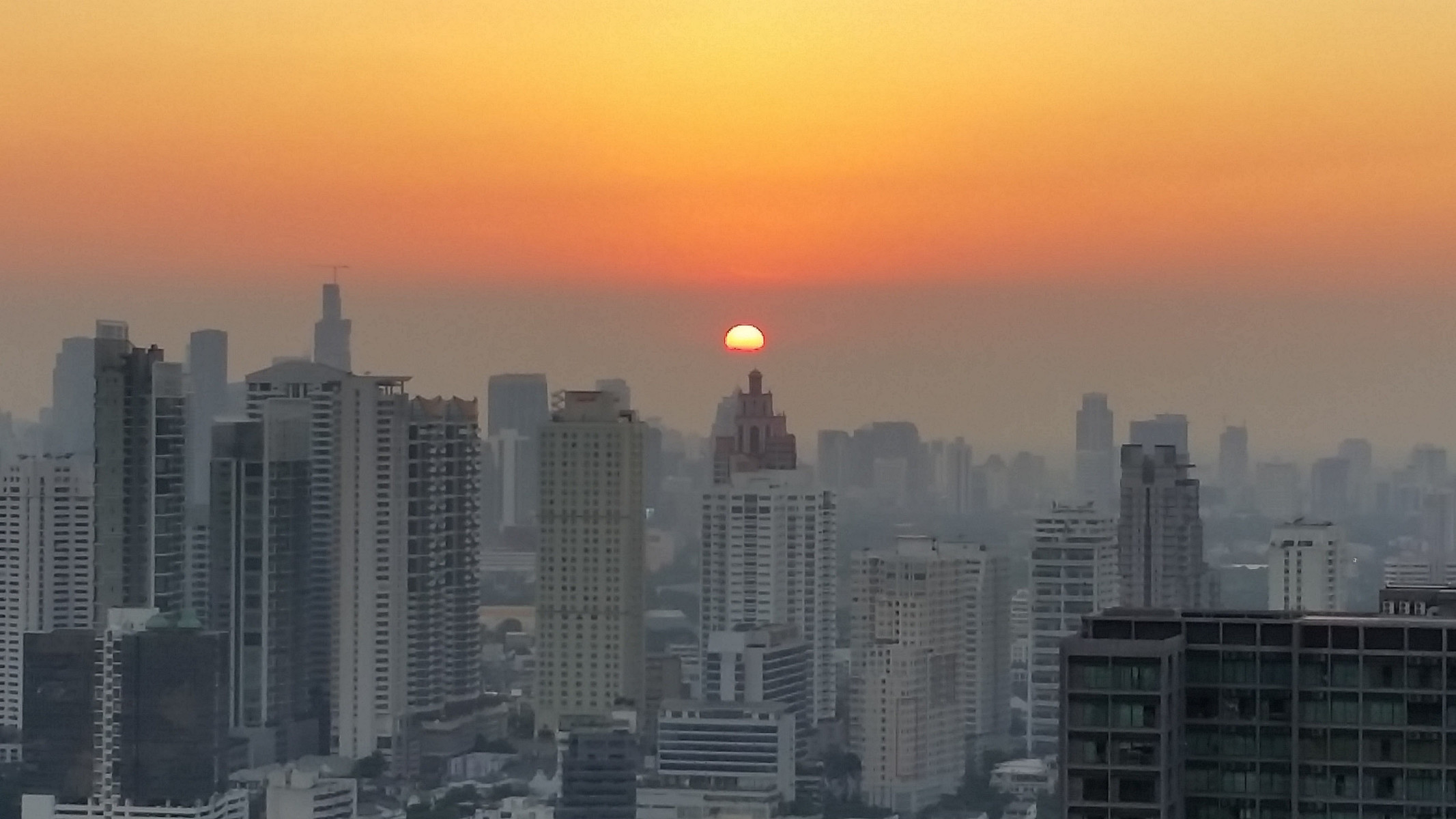
From the moment we landed, it was immediately evident that we had left Indonesia behind us. Our taxi sailed along at high speeds along an 8 lane highway with hardly a scooter to be seen.
Upon arrival at the Marriott in the Sukhumvitneighborhood of Bangkok, we felt at home and eagerly looking forward to soft beds and fast, reliable internet for the next few days. Arriving on a Friday evening,
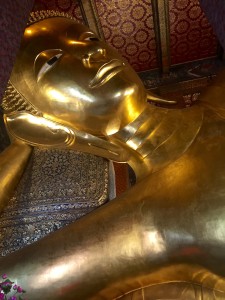 we decided to jump right into things and took the sky train and metro across town to a popular night market with the BKK hipster crowd. Selecting and ordering among the bountiful food options was a bit daunting but we managed to procure a meal of satay, tom yum soup and some macaroons for dessert. While detouring to a nearby mall to use the restroom, we happened upon a lip sync completion. Dozens of local youth dance teams were performing choreographed routines to the delight of hundreds of screaming fans – screaming akin to fans at a One Direction concert. Well, one of Gunnar’s secret talents is his ability is to produce an impressive, high pitched scream. Gunnar had found his people. We enjoyed several routines with Gunnar adding his voice to the cacophony of the other teenage girls that night.
we decided to jump right into things and took the sky train and metro across town to a popular night market with the BKK hipster crowd. Selecting and ordering among the bountiful food options was a bit daunting but we managed to procure a meal of satay, tom yum soup and some macaroons for dessert. While detouring to a nearby mall to use the restroom, we happened upon a lip sync completion. Dozens of local youth dance teams were performing choreographed routines to the delight of hundreds of screaming fans – screaming akin to fans at a One Direction concert. Well, one of Gunnar’s secret talents is his ability is to produce an impressive, high pitched scream. Gunnar had found his people. We enjoyed several routines with Gunnar adding his voice to the cacophony of the other teenage girls that night.
The following morning was Easter Sunday and to our delight the Easter Bunny managed to locate us even up on the 38th floor to leave some baskets behind. It wasn’t exactly like being home, but after a delicious brunch, it was a close second. Later we ventured out to spend a few hours exploring the grounds around Wat Pho, a 16th century Buddhist temple
that contains a 43 meter long statue of recumbent Buddha as he prepares to enter nirvana. Procuring a knowledgeable local guide was once again helpful making the history come alive during our time there.
Our first big lesson of the trip was soon to follow. Returning from the temple that afternoon our cab driver offered to take us 1.5 hour each way to a floating market outside of Bangkok for the US equivalent of around $15. This low price should have triggered our internal alarms, but we failed to pick up the signals…
The photographs in his cab looked like it would be an authentic adventure and we agreed to meet again early the next morning to travel to the market. Upon arrival, the long boat tour operators were asking the shocking equivalent of $200 for a 1.5 hour tour through the canals of the market. For just $50 we could add on an elephant ride at the adjacent elephant farm, but we couldn’t even bear thinking about the horrible conditions those animals must be subjected too as part of such a shady operation. The market tour alone was such an outrageous price that we were prepared to leave, eat the cab fare and the 3 hours of car travel.
Seeking council from our driver, he told us that $135 would be the best we could do, advice that in retrospect was being fueled by the commission that he was no doubt receiving for bringing us out to such a racket. Rather than even try to bargain, we conferred as a family and decided to offer them a single firm price that we were willing to pay for the floating market. We were in unanimous agreement if they wouldn’t accept, we were leaving. Our offer of ~$63 USD was accepted in the end – still a ridiculous sum, but what we felt the experience would be worth to us. The market operator told us as we were boarding the boat that this was the “best price ever” and not to share this information with the other guests milling about in similar sticker shock. 
Once upon a time, I am sure the market served many of the residents of the surrounding mangrove islands and resembled the pictures we were shown the day before. Today, the Damneon Saduak Market serves nearly exclusively to sell overpriced trinkets and food items to gullible tourists. Upon returning home and reading the Trip Advisor comments that evening, something we will ALWAYS DO in advance in the future, we were appalled to learn how many tourist pay the full asking price. In the end, our lesson wasn’t too painfully expensive and we are much the wiser for it…
We left Bangkok ready for new adventures on the Island of Koh Tao.
 The Time to Wander
The Time to Wander

